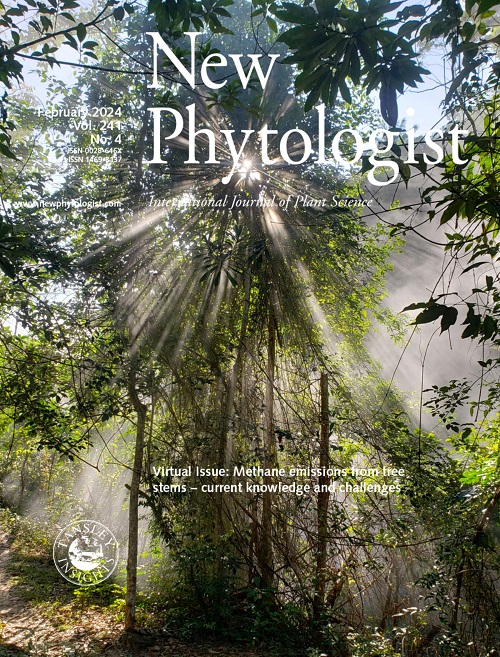血管形成层生长调控程序的镶嵌组合:从早泥盆纪的观点
IF 8.1
1区 生物学
Q1 Agricultural and Biological Sciences
引用次数: 0
摘要
次生生长的证据延伸到早泥盆纪,407 万年前,人们对这一关键发展特征的起源速度和模式提出了疑问。为了解决这些问题,我们分析了四种最古老的化石植物的解剖结构,这些植物具有良好的木质组织特征;其中一个代表一个新属,在这里正式描述。使用醋酸纤维素剥离技术和相关方法记录了新化石。我们使用结构指纹的范式来识别基于化石解剖的形成层生长的发育成分。我们将发展推断整合在二次生长模块化调节的理论框架内。这些化石具有与作用于形成层生长的四种不同调节机制(模块)组合一致的结构指纹,代表了四种不同的次生生长模式。不同的次生生长模式表明,形成层生长是一个调节模块的集合,其在木本植物中的部署遵循马赛克模式,这可能代表表现出木质生长的年轻谱系的祖先。在早泥盆纪的木材解剖中,不同的木材发育模式占据了广阔的形态空间,这表明次生生长及其模块化成分的起源早于这一时期。本文章由计算机程序翻译,如有差异,请以英文原文为准。
Mosaic assembly of regulatory programs for vascular cambial growth: a view from the Early Devonian
- Evidence for secondary growth extends into the Early Devonian, 407 million years ago, raising questions about tempo and mode of origination of this key developmental feature. To address such questions, we analyze anatomy in the four oldest fossil plants with well-characterized woody tissues; one of these represents a new genus, described here formally.
- The new fossil is documented using the cellulose acetate peel technique and associated methods. We use the paradigm of structural fingerprints to identify developmental components of cambial growth based on fossil anatomy. We integrate developmental inferences within a theoretical framework of modular regulation of secondary growth.
- The fossils possess structural fingerprints consistent with four different combinations of regulatory mechanisms (modules) acting in cambial growth, representing four distinct modes of secondary growth.
- The different modes of secondary growth demonstrate that cambial growth is an assemblage of regulatory modules whose deployment followed a mosaic pattern across woody plants, which may represent ancestors of younger lineages that exhibit woody growth. The diverse modes of wood development occupy a wide morphospace in the anatomy of wood in the Early Devonian, suggesting that the origins of secondary growth and of its modular components pre-date this interval.
求助全文
通过发布文献求助,成功后即可免费获取论文全文。
去求助
来源期刊

New Phytologist
PLANT SCIENCES-
CiteScore
17.60
自引率
5.30%
发文量
728
审稿时长
1 months
期刊介绍:
New Phytologist is a leading publication that showcases exceptional and groundbreaking research in plant science and its practical applications. With a focus on five distinct sections - Physiology & Development, Environment, Interaction, Evolution, and Transformative Plant Biotechnology - the journal covers a wide array of topics ranging from cellular processes to the impact of global environmental changes. We encourage the use of interdisciplinary approaches, and our content is structured to reflect this. Our journal acknowledges the diverse techniques employed in plant science, including molecular and cell biology, functional genomics, modeling, and system-based approaches, across various subfields.
 求助内容:
求助内容: 应助结果提醒方式:
应助结果提醒方式:


